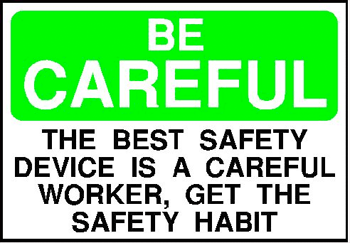Safety Tips for Sweeping Professionals |
Safety Relies on Reading, Reviewing and Utilizing Safe Practices Every TimeOngoing safety relies on involvement by everyone in your organization, from the top manager to the newest employee.by Ranger Kidwell-Ross, editor, WorldSweeper.com 
The impetus for this article is a fatal accident that occurred in New Hampshire on July 5, 2011. It is dedicated to the memory of Patrick J. MacDonald, who was killed after getting trapped in an Elgin Pelican while performing maintenance on the machine. Mr. MacDonald apparently became somehow entangled in the Pelican's hopper while working on it. Whatever job you or one of your employees is performing in or around a sweeper, the fact is that danger exists. That's why it is extremely important – no, make that mandatory – that anyone who is working on or around a particular sweeper has at the very least read the safety section of the operators manual and verifiably understood every part of it. In it will be detailed the various safety considerations to follow during any interaction with the machine. There are two basic types of danger around a sweeper. One involves the operator and/or person working on the machine itself. The other type of danger is to others who may be around the machine, especially during operation. Let's initially discuss the first type of danger. Your sweeper's (and other equipment's) Operators Manual is exactly what the title suggests: Absolutely no one should be operating any type of equipment without having read the manual that comes with the machine. Among other information, this document is designed to spell out every aspect of how to safely operate the machine. This is not a document that should just be read once; it is one that should be reviewed periodically, as well. You should require that anyone operating a piece of equipment initially read the Operators Manual. Then, require that they review the manual periodically. Also get them to sign for the fact they have done so, and keep this information on file in their personnel records.
Many equipment dealers offer training as a part of their sales process and customer service programs. Often there is a test after these training sessions. If your operator cannot pass the test do not let them operate or work on the equipment. Also make time for some hands-on training with seasoned operators who have a positive safety and operational record. The larger or more complex (and thus dangerous) the machine, the more in-depth this training should be. Now, let's discuss the safety of those around the sweeper during operation. In one regard, sweepers are much like fire trucks: at some time or another they attract kids running alongside. In addition, they are noisy, large and cumbersome. Sweepers also typically have a curb room outside of the normal vehicle radius during operation and they offer limited visibility while backing. All of these can contribute to bystander accidents. Be sure you have developed safety protocols for your sweeper operators and that these cover safe practices when there are pedestrians or ground personnel present. It is one thing to operate a parking lot sweeper in the middle of the night when no one is around; it is quite another issue to operate a sweeper in the midst of a road paving crew or sweeping the streets while there are pedestrians and vehicles present.
Do not rely on an initial training without follow-up or follow-on training. The fact is, it is human nature to cut corners after doing a familiar job for many years. Seasoned employees, especially, will do things like skipping putting the safety chocks up while working under a hopper because "they'll only be under it for a few seconds." Be sure to conduct ongoing training on safety. Encourage your employees to bring up safety issues and document them in an ongoing "Safety Best Practices" type of document that is available and required reading for all employees they might pertain to. Periodically, assign a supervisor to do an assessment on the safety practices of each of your employees who operates a sweeper or other heavy equipment. To again quote John Meola: "The equipment and machinery produced today are the safest and most reliable ever made. However, to both get the most out of the machine and also assure your employees' safety, it's not enough to just have a comprehensive safety program in place on all jobs and for all job functions. Further, you must keep it relevant, timely, frequently referenced and backed up by top management. Keep your operators and ground crews informed of the hazards they face (i.e., by reading the machine manual), keep them motivated and aware and have management recognition of their accident-free achievements. " I encourage you to review the other articles on safety found in this area of the WorldSweeper website. There is not another topic that's more important for your employees or the overall welfare of your business or organization than safety. Ranger Kidwell-Ross is editor of WorldSweeper.com and has been covering issues in the power sweeping industry since 1988. His email address editor@worldsweeper.com. |
© 2005 - 2021 All rights reserved. |
Back to Safety Tips Table of ContentsSite Map / Table of ContentsSite Map / Table of Contents |